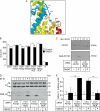FXYD proteins reverse inhibition of the Na+-K+ pump mediated by glutathionylation of its beta1 subunit
- PMID: 21454534
- PMCID: PMC3099672
- DOI: 10.1074/jbc.M110.184101
FXYD proteins reverse inhibition of the Na+-K+ pump mediated by glutathionylation of its beta1 subunit
Abstract
The seven members of the FXYD protein family associate with the Na(+)-K(+) pump and modulate its activity. We investigated whether conserved cysteines in FXYD proteins are susceptible to glutathionylation and whether such reactivity affects Na(+)-K(+) pump function in cardiac myocytes and Xenopus oocytes. Glutathionylation was detected by immunoblotting streptavidin precipitate from biotin-GSH loaded cells or by a GSH antibody. Incubation of myocytes with recombinant FXYD proteins resulted in competitive displacement of native FXYD1. Myocyte and Xenopus oocyte pump currents were measured with whole-cell and two-electrode voltage clamp techniques, respectively. Native FXYD1 in myocytes and FXYD1 expressed in oocytes were susceptible to glutathionylation. Mutagenesis identified the specific cysteine in the cytoplasmic terminal that was reactive. Its reactivity was dependent on flanking basic amino acids. We have reported that Na(+)-K(+) pump β(1) subunit glutathionylation induced by oxidative signals causes pump inhibition in a previous study. In the present study, we found that β(1) subunit glutathionylation and pump inhibition could be reversed by exposing myocytes to exogenous wild-type FXYD3. A cysteine-free FXYD3 derivative had no effect. Similar results were obtained with wild-type and mutant FXYD proteins expressed in oocytes. Glutathionylation of the β(1) subunit was increased in myocardium from FXYD1(-/-) mice. In conclusion, there is a dependence of Na(+)-K(+) pump regulation on reactivity of two specifically identified cysteines on separate components of the multimeric Na(+)-K(+) pump complex. By facilitating deglutathionylation of the β(1) subunit, FXYD proteins reverse oxidative inhibition of the Na(+)-K(+) pump and play a dynamic role in its regulation.
Figures








Similar articles
-
Oxidative inhibition of the vascular Na+-K+ pump via NADPH oxidase-dependent β1-subunit glutathionylation: implications for angiotensin II-induced vascular dysfunction.Free Radic Biol Med. 2013 Dec;65:563-572. doi: 10.1016/j.freeradbiomed.2013.06.040. Epub 2013 Jun 28. Free Radic Biol Med. 2013. PMID: 23816524 Free PMC article.
-
Reversible oxidative modification: a key mechanism of Na+-K+ pump regulation.Circ Res. 2009 Jul 17;105(2):185-93. doi: 10.1161/CIRCRESAHA.109.199547. Epub 2009 Jun 18. Circ Res. 2009. PMID: 19542013
-
Susceptibility of β1 Na+-K+ pump subunit to glutathionylation and oxidative inhibition depends on conformational state of pump.J Biol Chem. 2012 Apr 6;287(15):12353-64. doi: 10.1074/jbc.M112.340893. Epub 2012 Feb 21. J Biol Chem. 2012. PMID: 22354969 Free PMC article.
-
[FXYD proteins: novel regulators of Na,K-ATPase].Med Sci (Paris). 2006 Jun-Jul;22(6-7):633-8. doi: 10.1051/medsci/20062267633. Med Sci (Paris). 2006. PMID: 16828040 Review. French.
-
Coordinated regulation of cardiac Na(+)/Ca (2+) exchanger and Na (+)-K (+)-ATPase by phospholemman (FXYD1).Adv Exp Med Biol. 2013;961:175-90. doi: 10.1007/978-1-4614-4756-6_15. Adv Exp Med Biol. 2013. PMID: 23224879 Review.
Cited by
-
Protein kinase-dependent oxidative regulation of the cardiac Na+-K+ pump: evidence from in vivo and in vitro modulation of cell signalling.J Physiol. 2013 Jun 15;591(12):2999-3015. doi: 10.1113/jphysiol.2013.252817. Epub 2013 Apr 15. J Physiol. 2013. PMID: 23587884 Free PMC article.
-
"Oxygen Sensing" by Na,K-ATPase: These Miraculous Thiols.Front Physiol. 2016 Aug 2;7:314. doi: 10.3389/fphys.2016.00314. eCollection 2016. Front Physiol. 2016. PMID: 27531981 Free PMC article. Review.
-
Reactive Oxygen Species Modulation of Na/K-ATPase Regulates Fibrosis and Renal Proximal Tubular Sodium Handling.Int J Nephrol. 2012;2012:381320. doi: 10.1155/2012/381320. Epub 2012 Feb 23. Int J Nephrol. 2012. PMID: 22518311 Free PMC article.
-
S-glutathionylation of the Na,K-ATPase catalytic α subunit is a determinant of the enzyme redox sensitivity.J Biol Chem. 2012 Sep 14;287(38):32195-205. doi: 10.1074/jbc.M112.391094. Epub 2012 Jul 13. J Biol Chem. 2012. PMID: 22798075 Free PMC article.
-
Oxidative inhibition of the vascular Na+-K+ pump via NADPH oxidase-dependent β1-subunit glutathionylation: implications for angiotensin II-induced vascular dysfunction.Free Radic Biol Med. 2013 Dec;65:563-572. doi: 10.1016/j.freeradbiomed.2013.06.040. Epub 2013 Jun 28. Free Radic Biol Med. 2013. PMID: 23816524 Free PMC article.
References
Publication types
MeSH terms
Substances
Grants and funding
LinkOut - more resources
Full Text Sources
Other Literature Sources
Molecular Biology Databases

